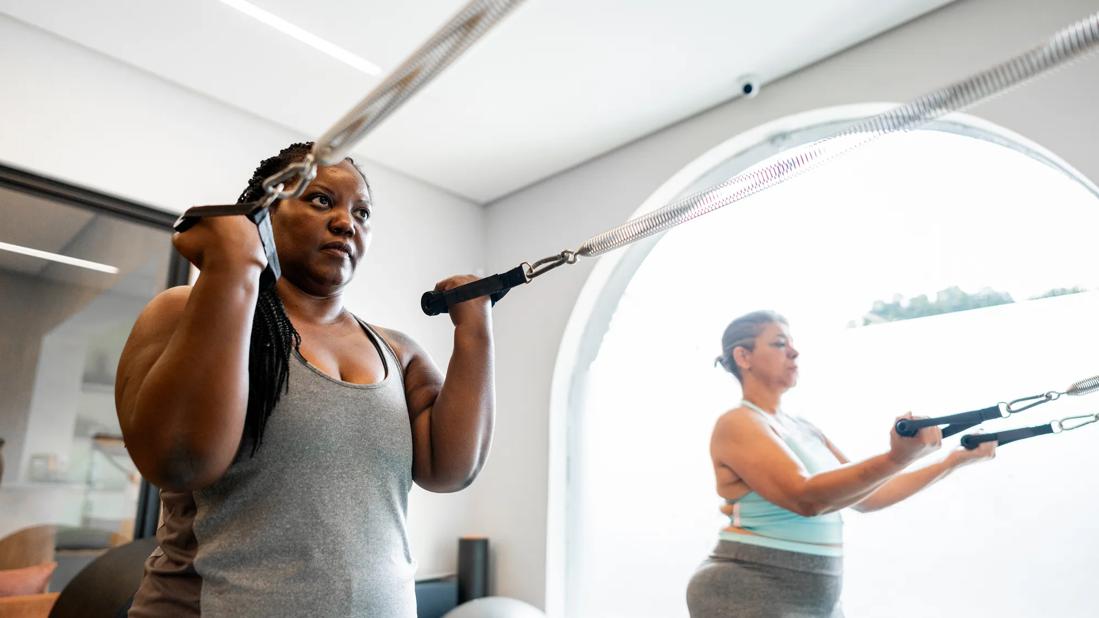Your body may temporarily add a few pounds as it adjusts to new demands and grows stronger

You start a new exercise program with dreams of changing your body. When you step on the scale a week later, you see results ― but the numbers aren’t exactly moving in the direction you wanted.
Advertisement
Cleveland Clinic is a non-profit academic medical center. Advertising on our site helps support our mission. We do not endorse non-Cleveland Clinic products or services. Policy
That’s right … after all that hard work, your new workout routine led to you GAINING weight. How in the world is that possible?
As it turns out, a slight weight increase is typical as you begin a new fitness journey. To explain why you might add a few pounds (at least temporarily), we turn to physical therapist Gary Calabrese, DPT.
Your body goes through changes as you begin an exercise routine. It’s part of a natural physiological process as you begin putting more demands on your muscles, says Dr. Calabrese.
Here’s how that new workout can bring added pounds.
Exercise puts stress on your body that can lead to small micro tears (also known as micro-trauma) in your muscles. In response to the damage, your body activates its internal repair system to trigger inflammation.
“Basically, your body retains fluid around the micro tear to try to heal it,” explains Dr. Calabrese.
Water has weight, of course, which is why this healing mechanism can add pounds after a challenging workout.
The good news? The inflammation (and extra weight) typically disappears within a day or so, according to Dr. Calabrese. Plus, your “repaired” muscles come back stronger to help you make fitness gains.
If you’re working out more, you’re going to need extra energy ― and those power reserves can show on the scale at first.
Advertisement
Glucose is the fuel your muscles use for energy. When you start to exercise more regularly, your body keeps reserves of glucose (in the form of glycogen) in your muscles to answer the call the next time you work out.
Glycogen binds with water as part of the process, which can add 1 to 3 pounds of initial water weight gain.
The effect, however, is short-lived and should end in a few weeks to a month.
Exercising can make you REALLY hungry. But while it’s important to refuel after a workout, it’s also possible to overdo it when you hit the kitchen to grab a bite, cautions Dr. Calabrese. A few minutes of munching can easily lead to you consuming more calories than you just burned.
The solution? Put as much thought and effort into your post-workout snack as you put into your exercise session. Focus on eating proteins and nutritious foods that will fill you up and leave you less likely to grab a less-than-healthy option later.
As you exercise and build muscle, don’t be surprised to see a trimmer you in the mirror but a larger number on the scale. The reason? Muscle is denser (meaning a lot less fluffy) than fat, says Dr. Calabrese.
Put another way, 10 pounds of muscle takes up a lot less space than 10 pounds of fat.
So, as you start working out regularly and building strength, the new muscle you build may eventually weigh more than the fat you’ve burnt off. (Learn more about muscle weight vs. fat weight.)
It often takes at least a month or two to add enough muscle to tip the scale, so don’t be surprised if it happens.
Know this, too: Muscle burns more calories for you, which will pay off in a leaner and more fit body in the long run. (Ten pounds of muscle burns 50 calories a day at rest while 10 pounds of fat burns 20.)
When you start a workout program, don’t fixate on your scale to determine the effectiveness of the new exercise for you. That’s often NOT the best measure of whether you’re making healthy changes.
Talk to your healthcare provider, physical therapist or athletic trainer if you have questions about changes to your body, too. They can help you map out your progress.
“The key point here is that weight and muscle mass changes will occur,” states Dr. Calabrese. “You may gain a little weight at first, which isn’t what some people see as headed in a positive direction. But stick with it, because you’ll eventually see the long-term benefits.”
Advertisement
Learn more about our editorial process.
Advertisement

Lower-intensity workouts can deliver high-quality health and fitness results

Incremental changes in your exercise routine can improve your strength and endurance over time

Understanding heart rate zones can help you tailor your workout to reach your goals

Increase the size of your muscles by bulking up on protein and focusing on slow, intense movements with progressive overloading

Low-impact exercises help you recover faster between sets, during cool downs and on rest days

Eccentric is slow and steady, while concentric is fast and controlled

Weightlifting can help you build muscle mass, reduce joint pain and increase flexibility to improve your quality of life

Abdominal exercises don’t have to be done on the floor!

Babies can get congested easily, but you can calm their cough by keeping them hydrated, using nasal drops and running a humidifier

Weight loss may cause loose, sagging skin and muscle loss to your rear

Several conditions, like vitiligo and fungal infection, can cause a loss of pigmentation, leading to white spots or patches on your skin